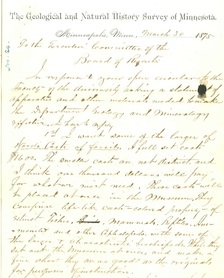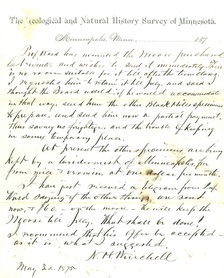As we shared in a blog post a few months ago, the University’s “General Museum” – the museum established by the 1872 act that created the state Geological and Natural History Survey – started humbly. It wasn’t until three years after the initiation of the Survey that a location was secured in order to adequately display and store the geological and biological materials collected for the University. While construction was nearing completion on what became known as the “Old Main” building in 1875, Survey Director and State Geologist Newton Horace Winchell went about the business of setting up the museum collections for display. To do so, Winchell turned to the expert in all things related to mounted mammals and minerals of the time – Professor Henry Augustus Ward of Ward’s Natural History Establishment.
Ward’s Natural History Establishment was established in 1862 by naturalist Henry A. Ward in Rochester, New York. The Establishment was the leading supplier of biological specimens, taxidermy equipment, mounts, minerals, casts, fossils, and other natural science materials in the late 19th century. While studying the natural sciences at the Ecole des Mines and the Jardin des Plantes in Paris, Ward traveled throughout Europe and developed an extensive personal collection of minerals and other geological materials. His personal collection became the base material for the Establishment, which was initially connected to the University of Rochester, where Ward served as a professor. Ward also added zoological materials to his offerings and hired European taxidermists to prepare mounted animals and share European methods of skin preparation and modeling with American naturalists (at the time, taxidermy techniques were more advanced in Europe than in the U.S). Major institutions of higher education, to include Yale, Princeton, the University of Virginia, and the University of Minnesota in 1875, purchased Establishment materials to develop their study collections and teaching materials in the natural sciences. By the end of the 19th century, Ward’s Natural History Establishment was the largest supplier of scientific specimens and other materials to museums and institutions throughout the world.
 A letter found in the supplemental files to the Board of Regents meetings dated March 30, 1875 reveals Winchell’s request to the Board of Regents for funding to acquire materials from Ward’s Establishment for the museum collection:
A letter found in the supplemental files to the Board of Regents meetings dated March 30, 1875 reveals Winchell’s request to the Board of Regents for funding to acquire materials from Ward’s Establishment for the museum collection:
“In response to your open circular to the faculty of the University asking a statement of apparatus and other materials needed to make the Department [of] Geology and Mineralogy effective I have to reply.
1st I want some of the larger of Wards Casts of Fossils. A full set costs $1600. The smaller casts are not distinct and I think one thousand dollars will pay for whatever most need. These casts will be placed about in the Museum. They comprise life-like casts colored properly of extinct fishes, mammals, reptiles, Ammonites and other cephalopods with some of the larger and characteristic brachiopods. While they set out the Museum at once and make a fine show they are as good as the originals for purposes of instruction.”
Winchell requested additional funds in order to mount the specimens he acquired on the General George A. Custer-lead expedition to the Black Hills in the Dakota Territory the previous summer. Winchell indicated to the Board of Regents, based on estimates given by Ward, that “between five and six hundred dollars” would be needed to mount the deer, elk, antelope, bear, and other mammals.
 In the 4th annual report of the Survey for the year 1875, Winchell reported that the mammals collected on the Black Hills expedition, along with a moose killed in Otter Tail county, were sent to Ward at the Establishment to be mounted for the museum collection. Details surrounding the preparation of the mammals are found in the supplemental Board of Regents files, in a letter from Winchell dated May 3, 1875:
In the 4th annual report of the Survey for the year 1875, Winchell reported that the mammals collected on the Black Hills expedition, along with a moose killed in Otter Tail county, were sent to Ward at the Establishment to be mounted for the museum collection. Details surrounding the preparation of the mammals are found in the supplemental Board of Regents files, in a letter from Winchell dated May 3, 1875:
“Prof Ward has mounted the Moose purchased last winter and wishes to send it immediately. There is no room suitable for it till after the term closes. I requested him to retain it till July and said I thought the Board would, if he would accommodate in that way, send him the other Black Hills specimens to prepare and send him now a partial payment, thus saving us freightage, and the trouble of keeping in some temporary place.
At present the other specimens are being kept by a taxidermist of Minneapolis, free from mice and vermin, at one dollar per month.
I have just received a telegram from Prof Ward saying if the other things are sent now, and $60 on the moose – he will keep the Moose till July. What shall be done? I recommend that his offer be accepted as it is what I suggested.”
The 4th Annual Survey Report indicates that Ward completed the preparation of the mammals and held the mounts in storage in Rochester until construction on Old Main was finished. Winchell received additional funding to make cases for the geological materials, and a fund was set up to raise the $1500 necessary to purchase Ward’s Casts of Fossils for illustrative instructional purposes. A list of the casts is also provided in the report.
By the end of the fourth year of the Geological and Natural History Survey of the State of Minnesota, after much effort and preparation, Winchell and the Board of Regents were finally able to implement Section 6 of the original 1872 law that created the Survey:
“It shall be the duty of the said board of regents to cause proper specimens, skillfully prepared, secured and labeled of all rocks, soils, ores, coals, fossils, cements, building stones, plants, woods, skins and skeletons of animals, birds, insects and fishes, and other mineral, vegetable and animal substances and organisms discovered or examined in the course of said surveys, to be preserved for public inspection free of cost, in the University of Minnesota, in rooms convenient of access and properly warmed, lighted, ventilated and furnished, and in charge of a proper scientific curator.”